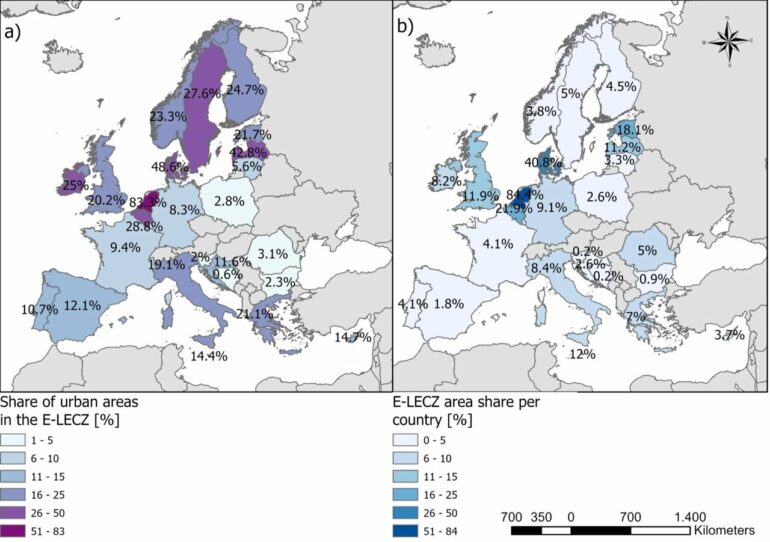Europe’s coasts are densely populated and already affected by the impacts of sea level rise. In addition to traditional, cost-intensive coastal protection measures, spatial land use planning strategies are becoming increasingly important to protect coastal communities from damage during high tides or storm surges. Such planning tools include managed retreat or even the establishment of so-called “setback zones,” coastal areas where further development is restricted.
A research team from Kiel University has carried out the first Europe-wide modeling study of the effectiveness of different types of setback zones in reducing future urban exposure. According to the study, in most EU countries, the establishment of the most effective setback zones could result in new urban development being at least 50 percent less vulnerable to rising sea levels and associated hazards by the year 2100. The researchers recently published the results in Scientific Reports.
“Our modeling study is the first of its kind and can help to develop appropriate adaptation measures to protect cities and urban areas along Europe’s coasts,” says first author Dr. Claudia Wolff, a postdoctoral researcher in the Coastal Risks and Sea Level Rise group at the Institute of Geography in the priority research area Kiel Marine Science (KMS) at Kiel University.
The results show that the future exposure of coastal cities to sea level will largely depend on how urban space in EU coastal areas is planned, designed and developed.
“The development of coastal setback zones should consider not only the distance from the coast, but also the elevation of the terrain above sea level.To our knowledge this aspect is currently not being discussed at the European level. We believe by taking this into account, cities and coastal areas can be better protected from the potential risks of rising sea levels in the future,” says Wolff.
Urban development modeled for all EU coastal member states on a country-specific basis
As part of their modeling study, the researchers developed various scenarios to project the urban extent of the low-lying coastal zone below 20 meters above sea level (known as the Extended Low-Elevation Coastal Zone, E-LECZ). This area covers 6.3 percent of the EU coastal states, where 15.1 percent of the urbanized area is currently located.
In addition to the physical component of how coastal areas are changing due to sea level rise, the research team looked specifically at socio-economic factors, including different types of setback zones. In doing so, they investigated how urban areas might change as a result of higher urban development, and how the exposure to rising sea levels might change in Europe in the future.
The scientists modeled country-specific urban development for all EU coastal member states. To do this, the researchers first used an artificial neural network to predict the urban development potential for each country based on parameters such as elevation, population density or distance from the road network.
They then calculated the future demand for urban land, taking into account various socio-economic factors, and created spatially explicit urban extent projections with a resolution of 100 meters. Various setback zones were integrated into these projections to analyze the effectiveness of such spatial planning tools in the face of rising sea levels.
Further research is needed on a local level
Setback zones are particularly interesting for countries and regions with long coastlines. According to Wolff, not every stretch of coastline can be protected.
More local and detailed studies are needed in the future for concrete planning and decisions. Professor Athanasios Vafeidis, co-author of the study and head of the Coastal Risks and Sea Level Rise research group at Kiel University, is conducting research on this in the EU Horizon 2020 project “Coastal Climate Core Services” (CoCliCo).
“The project aims to better inform decision-makers about adaptation measures for coastal protection and sea level rise,” says Vafeidis. As a tool, the CoCliCo project envisions an integrative data service in the form of a pan-European, open and web-based platform that can be used by governments, NGOs, cities, industries, insurance companies or private individuals to inform about and exploit current and future threats from sea level rise.
More information:
Claudia Wolff et al, Setback zones can effectively reduce exposure to sea-level rise in Europe, Scientific Reports (2023). DOI: 10.1038/s41598-023-32059-9
Citation:
Modeling future urban development on European coasts to minimize the risk of rising sea levels (2023, May 22)



